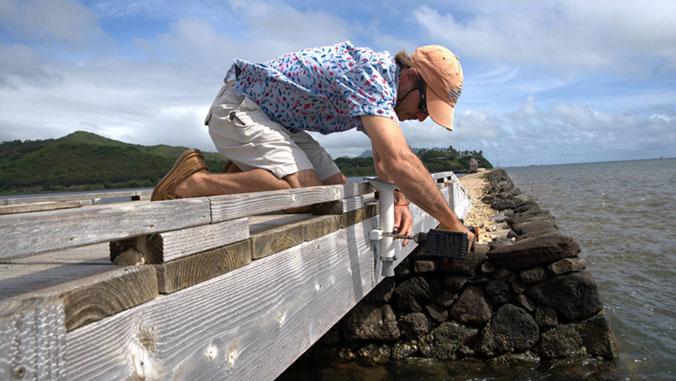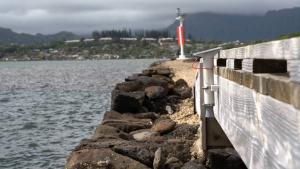
Hohonu, Inc., a University of Hawaiʻi technology startup that provides environmental water level monitoring to help communities adapt to climate change, has been selected to help to expand a water-level observing network in the Southeast U.S. region. Hohonu is one of four teams working with the Southeast Coastal and Ocean Observing Regional Association (SECOORA), which is a member of the U.S. Integrated Ocean Observing System, and part of NOAA.
SECOORA created the five-year project to help coastal managers plan for, manage and adapt to community flooding. As part of the project, Hohonu has partnered with non-profit American Shore and Beach Preservation Association and 54 communities to install water-level sensors that are deployed to areas between federal tide station assets to provide local water level observations and predictions to coastal communities.
“Our goal is to empower communities with data, and ultimately to transform how data is used to help communities adapt to climate change,” said Brian Glazer, Hohonu CEO and co-founder and oceanography associate professor at the UH Mānoa School of Ocean and Earth Science and Technology (SOEST).

More intense storms and frequent nuisance flooding have motivated communities across the southeast to develop prioritized sea-level-rise adaptation plans. Community-level data granularity will provide numerous economic benefits to local coastal communities that are presently brought to a full stand still when flooding shuts down critical infrastructure and transportation corridors.
“Hohonu’s data has become a source of knowledge that impacts how we manage our day-to-day operations as well as how we respond to extreme events like storms,” said Lucas Hernandez, resilience specialist at Kiawah Island, South Carolina. “Their network of sensors throughout the region paints an environmental picture we did not have before.”
Designing technology to fill a need
Hohonu’s mission is rooted in applying scientific environmental technology to help underserved communities. The company was incorporated in 2019, but its origin dates back to 2014 when Glazer became frustrated with the lack of environmental monitoring tools that were available to him while helping to restore an 800-year old Hawaiian fishpond.
Glazer teamed up with engineer Stanley Lio to develop groundbreaking, low-cost water level sensors that provide unprecedented insight on tides, floods and sea-level rise. Glazer has received previous funding from the National Science Foundation and Schmidt Marine Tech Partners to commercialize Hohonu. To him, hardware is only part of the solution.
“Democratizing access to ocean-observing technologies has always been my driving motivation,” Glazer stated. “And in order to deploy low-cost electronics, you need to invest heavily into the knowledge and software infrastructure to support those devices.”
This research is an example of UH Mānoa’s goal of Excellence in Research: Advancing the Research and Creative Work Enterprise (PDF) and Building a Sustainable and Resilient Campus Environment: Within the Global Sustainability and Climate Resilience Movement (PDF), two of four goals identified in the 2015–25 Strategic Plan (PDF), updated in December 2020.

